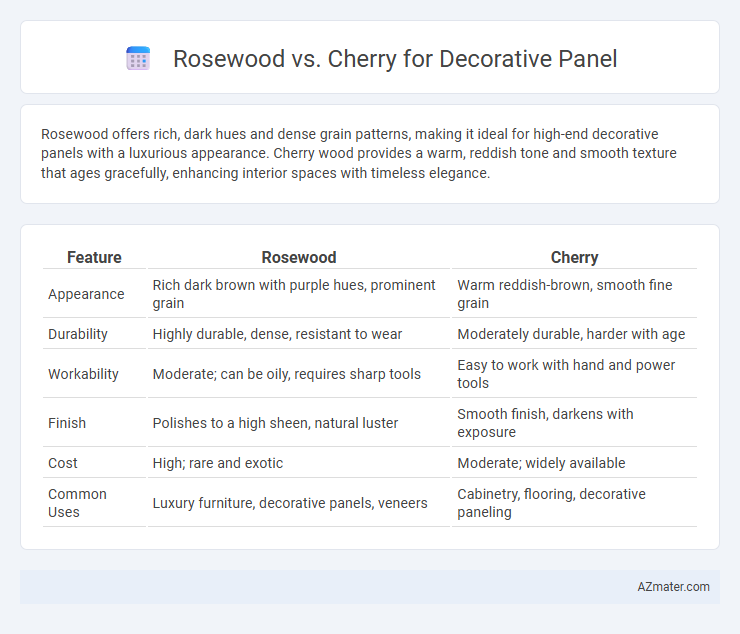Rosewood offers rich, dark hues and dense grain patterns, making it ideal for high-end decorative panels with a luxurious appearance. Cherry wood provides a warm, reddish tone and smooth texture that ages gracefully, enhancing interior spaces with timeless elegance.
Table of Comparison
| Feature | Rosewood | Cherry |
|---|---|---|
| Appearance | Rich dark brown with purple hues, prominent grain | Warm reddish-brown, smooth fine grain |
| Durability | Highly durable, dense, resistant to wear | Moderately durable, harder with age |
| Workability | Moderate; can be oily, requires sharp tools | Easy to work with hand and power tools |
| Finish | Polishes to a high sheen, natural luster | Smooth finish, darkens with exposure |
| Cost | High; rare and exotic | Moderate; widely available |
| Common Uses | Luxury furniture, decorative panels, veneers | Cabinetry, flooring, decorative paneling |
Introduction to Rosewood and Cherry Decorative Panels
Rosewood decorative panels showcase rich, dark hues with intricate grain patterns, providing a luxurious and exotic aesthetic ideal for upscale interiors. Cherry decorative panels feature warm, reddish tones and smooth, consistent grain, offering a timeless elegance that complements both traditional and modern decor. Both materials deliver exceptional durability and natural beauty, making them popular choices for high-end woodworking and interior design projects.
Botanical Origins and Availability
Rosewood, derived from the Dalbergia genus native to tropical regions of Central and South America, Africa, and Asia, is prized for its rich color variations and natural oils that enhance durability in decorative panels. Cherry wood, sourced primarily from the Prunus serotina tree native to North America, is known for its fine, closed grain and warm reddish-brown hue that deepens over time. Availability of rosewood is limited due to strict CITES regulations aimed at protecting endangered species, whereas cherry wood is more sustainably harvested and readily accessible in North American markets.
Color and Aesthetic Differences
Rosewood features a rich, deep reddish-brown color with dark veining, offering a luxurious and exotic aesthetic ideal for high-end decorative panels. Cherry wood displays a warm, reddish hue that deepens over time to a rich amber, providing a classic and elegant look favored in traditional and contemporary interiors. The distinct grain patterns of rosewood contribute to a dramatic visual impact, while cherry wood's finer, smoother grain creates a more subtle and refined appearance.
Grain Patterns: Rosewood vs Cherry
Rosewood features bold, dramatic grain patterns with dark streaks and rich, contrasting colors, creating a striking and exotic appearance on decorative panels. Cherry displays fine, smooth grain with subtle, flowing lines and a warm reddish-brown tone that deepens over time, offering a more classic and elegant look. Both woods provide unique aesthetic qualities, but Rosewood's intricate grain is ideal for making bold statements, while Cherry's uniform grain complements traditional design styles.
Durability and Hardness Comparison
Rosewood offers exceptional durability and hardness, typically registering around 2,800 on the Janka hardness scale, making it highly resistant to dents and wear in decorative panel applications. Cherry wood, with a Janka hardness of approximately 950, is softer and more prone to scratches but develops a rich patina over time, enhancing its aesthetic appeal. For decorative panels requiring robust longevity and resistance to damage, rosewood is preferable, while cherry suits interiors where a warm, evolving finish is desired.
Workability and Finishing Qualities
Rosewood offers excellent workability with its dense grain allowing smooth carving and shaping, though it requires sharp tools due to hardness. Cherry wood is easier to work with hand and power tools, providing a fine, even texture ideal for precise cuts and detailing in decorative panels. Both woods finish beautifully, with rosewood showcasing a rich, dark sheen and cherry developing a warm, reddish patina over time that enhances panel depth and elegance.
Cost and Market Value Analysis
Rosewood panels typically command a higher market value due to their rarity and deep, rich grain patterns, making them a premium choice for decorative applications. Cherry wood offers a more affordable alternative with a warm, reddish hue that darkens over time, appealing to cost-conscious buyers seeking elegant aesthetics. Cost analysis reveals Rosewood's price per square foot can be double that of Cherry, reflecting its scarcity and desirability in luxury interiors.
Best Applications for Rosewood Decorative Panels
Rosewood decorative panels are ideal for high-end interior applications such as luxury furniture, wall cladding, and intricate cabinetry due to their rich grain patterns and deep reddish-brown hues. They offer exceptional durability and natural resistance to wear, making them suitable for areas requiring both elegance and longevity. Rosewood's distinctive aroma and smooth finish enhance aesthetics in upscale residential and commercial spaces where premium materials are desired.
Ideal Uses for Cherry Decorative Panels
Cherry decorative panels are ideal for interior applications requiring a warm, rich aesthetic with smooth grain patterns, such as cabinetry, wall paneling, and furniture accents. Their natural reddish-brown hue deepens over time, enhancing spaces in kitchens, libraries, and offices where a classic, elegant look is desired. Compared to rosewood, cherry is more versatile and cost-effective, making it suitable for both traditional and contemporary designs.
Choosing the Right Wood for Your Décor Style
Rosewood offers rich, dark hues and intricate grain patterns that complement traditional or luxurious decor styles, creating a bold and elegant statement in decorative panels. Cherry wood features warm, reddish tones that deepen with age, providing a classic, timeless appeal suited for both modern and rustic interiors. Selecting between rosewood and cherry depends on your desired ambiance: choose rosewood for dramatic sophistication or cherry for warmth and versatility.

Infographic: Rosewood vs Cherry for Decorative Panel
 azmater.com
azmater.com